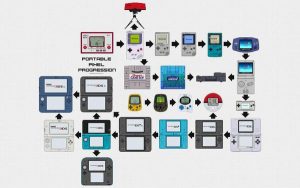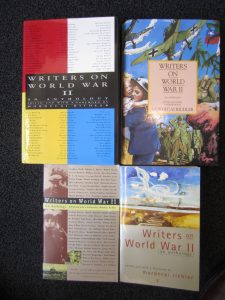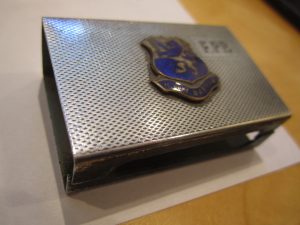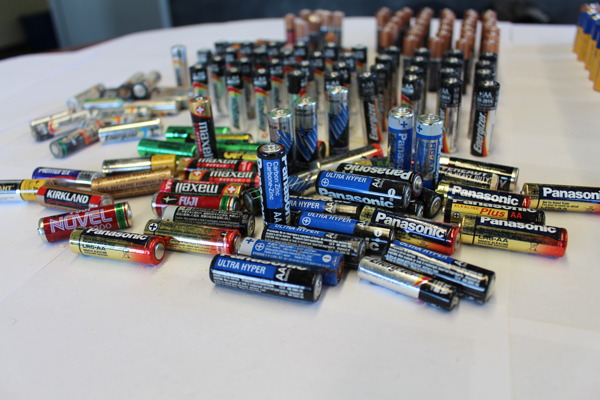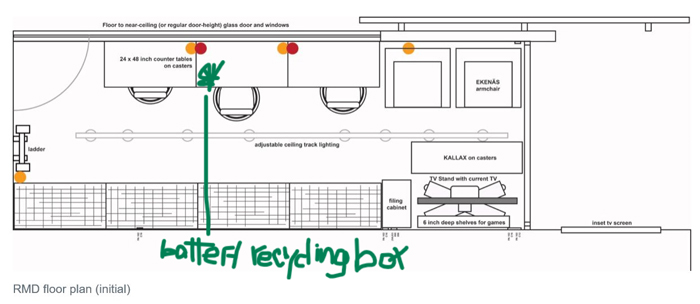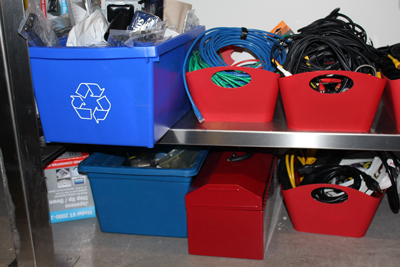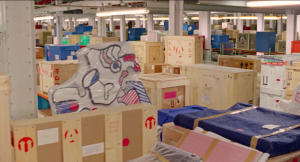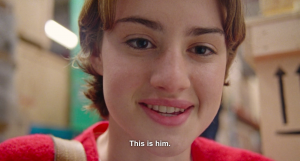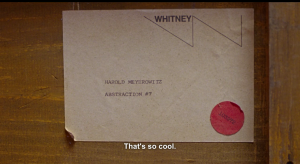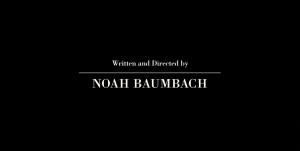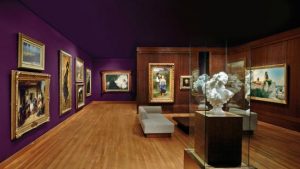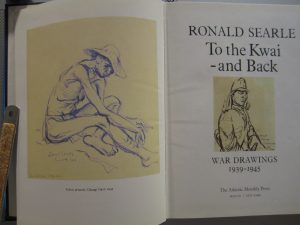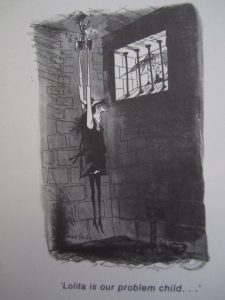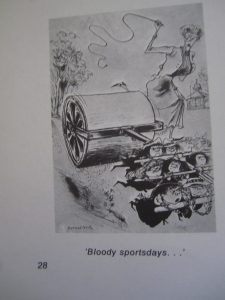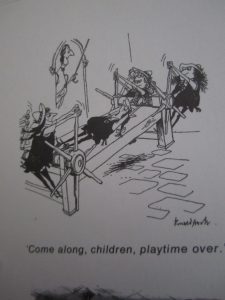The post The Rhizomic (Memory) Collection: A Non-Linear Approach to the Preservation of Video games, Game consoles, and their data. appeared first on &.
]]>The seminar “The Research Collection” has, in a way, encouraged me to reflect on my book and music collecting habits. To assess memories, I have preserved in the corners of my mind. To assess the value and relevance I place upon them. For the first time, I considered myself a collector of memories, not only of objects. If collecting is not limited to physical objects but also encompasses all sorts of memories; then, objects are a means to gain experiences that, in turn, will leave in us printed memories. Such aspects function at the personal level; however, what happens regarding the collection of objects at the University and Museum level? Sheila Brennan claims in “Making Room by Letting Go” that the purpose of collecting is to gather “the material culture evidence that will help historians interpret the lives of early 21st-century Americans.” The aim is clear: to gather as much relevant information as possible on a given object. Museums and Universities actively collect material heritage. Nevertheless, as Raiford Guins notes in “Museified,” museums have limited forms of access, for they let objects fall into oblivion (66). Some Universities, on the other hand, lack expert knowledge on the preservation of artifacts (Brennan). Then, in what ways can scholars and university students can aid in the preservation of cultural heritage? The purpose of this study is to present a non-centered approach for (1) collecting, (2) making accessible and (3) preserving material heritage based on Gilles Deleuze and Félix Guattari’s rhizome. Using such an approach I mean to gather software, hardware, design information, anecdotes and other relevant data used in game consoles and cartridges. By rhizome, let it be understood “an ascentered, non-hierarchical, nonsignifying system without a General and without an organizing memory or central automaton,” (21) as Deleuze and Guattari introduce it in “A Thousand Plateaus: Capitalism and Schizophrenia” I will begin by developing the notion of destabilizing the centrality of the object to map “assemblages” (connections.); then, I will move on to the process of mapping collective assemblages. I will finalize presenting a collaborative approach to the preservation of cultural heritage.
1 Collecting by Destabilizing the Centrality of the Object
In my experience, while preparing probes one and two for the Game Boy Classic and Tiny Toon Adventures Montana’s Madness gameplay, I found useful to approach each of these two objects using the question What does it function with? A question, Deleuze proposes in the Rhizome, with the intention of destabilizing the centrality of the object of study. The question “what does it function with” shatters the linear unity of the object. What is more, by placing the object inside an assemblage or multiplicity the Game Boy situates itself “at a higher unity, of ambivalence or overdetermination.” (6) Moreover, mapping the trajectory of the object allows me to stop considering the Game Boy as an object with which to play video games. Instead, I begin to consider the Game Boy as an event, an event which correlates with other events. For instance, when I situate the Game Boy (the event) between the eighties and the nineties the focus lies on the objects the GB echoes.
(Address the Audience)
Tell me, what do you see when you set your eyes on the GB?
(Pause)
Now, let us go back in time, to the year 1988 (one year before the launching of the GB)
Hint: Perhaps, you see an object you carry with you every day, everywhere.
Can you relate GB to two more objects?
Drawing back your attention, Deleuze claims that “any point of the rhizome can be connected to anything other, and must be.” (7). By mapping the first object (GB in this case), you approach other objects. You establish echoes not only from objects used in the past, but also establish echoes from current objects. I call the mapping process “mirroring.” Mirroring allows expanding lines of connection. In a way, the rhizomatic approach fosters relationships between fields (in terms of objects and disciplines of study) given that there is no central point, no actual origin and, above all no linearity, which brings me to my second point.
(A quick recap:
- A non-linear analysis of GB.
- Two (of many) lines of thought which can be further explored regarding the objects the GB mirrors, to start off.)
2 Making Accessible Encoded Knowledge/Mapping Collective Assemblages
Oversignifying brings about the collapse of the rhizome. In Deleuze’s words “a rhizome may be broken, shattered at a given spot, but it will start up again on one of its old lines, or on new lines.” (9) Now, let me show you (the audience) a map of a new rhizome on the GB, but whose focus is to place the GB, not as an event, but as a generator of experiences. Henry Lowood (qtd in Guins) establishes that experiences are “generated by a framework of rules, codes or stories and expressed through interaction, competition, or play.” (32) This type of rhizome requires help from scholars and students from disciplines other than Media Studies or English Literature to map “collective assemblages.” On the one hand, there is the technical system (matter) of the GB, which, when analyzed, makes visible the assembly language, commands, timings, and opcodes. To map these assemblages in the rhizome, students of Computer Science and scholars knowledgeable of such codes might work together to prepare and establish correlations with other objects which share (or not) similar technical systems. On the other hand, there is the gamer (actor) whose interaction with the game (as purchased) establishes a given number of screen memories (fragments) while playing the game. Moreover, at a metagame level, the gamer can also modify the technical system of the game to create a “unique” game. Hence, the gamer (player) becomes more than a consumer, becomes a game designer. By rearranging a couple of elements, the game designer produces a different output. Each of these members shares and submits their own generated experience be it by playing the game or by designing a game of their own. Experience and experimentation become visible herein, which brings me to my third point.
(A quick recap:
- Both scholars and students combine maps to represent the technical system of the object (GB in this case).
- There exists a sense of community before, during and after the mapping of the technical system of the object.)
3 Preserving Material Heritage
Regarding “forms of access” and forms of preservation. Sheila Brennan suggests in “Making Room by Letting Go” that institutions should “partner with other arts organizations to use collections in new ways.” Under the same premise, I would add the creation of a website in partnership with other universities. The collaborative creation of the website paves not only the ground for a major form of accessibility of information but also ensures the commitment of other institutions for the preservation of manuals, pictures, videos and generated experiences from their contributors. Again, since the gathering of knowledge is not centralized but becomes a shared experience, the rhizome seems to be an efficient way, to a certain degree, to preserve cultural capital for the future generations; however, some pitfalls should be considered: they are imaginative, historical, contextual and geographical. Given that once the website is online, database accessible online. The four pitfalls could converge to shift interpretations on the data allocated due to a shift in social and cultural ways of thinking and technological advancement. Therefore, I would suggest that to overcome such constraints, future scholars should encourage a “compare and contrast approach” to establish nuances and shifts in the signifying of objects and their data. Another way would be the preparation of a time capsule in the years to come, in which paper-based information and specific objects are allocated in one of the pillars of each partnered university, like the one located in the cornerstone of the Henry F. Hall Building (in 1967) at Concordia University. By preparing some time capsules, each capsule containing fragments of specific objects, the scholars dwelling in the Halls of Concordia in a hundred years’ time, will rethink and reinterpret such objects on their own terms, in accordance to the schools of thought available at that time. In a way, objects will not lose their relevance due to their study in the centuries to come.
(A quick recap:
- Knowledge is a shared experience.
- A collaborative gathering of collections ensures the accessibility and preservation of collections for cultural heritage.)
To sum up, the present study presents the rhizome as a non-hierarchical approach for the collecting, making accessible and preserving cultural capital, as Gilles Deleuze and Félix Guattari propose in “A Thousand Plateaus: Capitalism and Schizophrenia.” First, by studying the object through a non-linear analysis establishes connections among objects beyond definite historical times. Second, due to a lack of central automaton, the rhizome (as another approach to collect information) promotes collaborative work between both scholars and students, who blend maps of representation (data). Hence, they share personal experiences and knowledge, which in turn leads to ensuring the accessibility and preservation of collections using a digital repository.
(If time allows it!) (Please, meditate on the following train of thought: in the rhizome, there is not centrality, but multiplicity; there is not one entry point, but endless entry points to the study of objects; there is not a process of tracing of memories and objects; instead, there is “letting go” as part of the collecting process.)
Works Cited
Brenan, Sheila. “National Trust for Historic Places: Return to home page.” Making Room by
Letting Go: A Look at the Ephemerality of Collections – Preservation Leadership Forum
– A Program of the National Trust for Historic Preservation,
forum.savingplaces.org/blogs/special-contributor/2014/08/12/making-room-by-letting-
go-a-look-at-the-ephemerality-of-collections.
Deleuze, Gilles, and Felix Guattari. “Introduction: Rhizome.” A Thousand Plateaus. 11th ed. Minneapolis: U of Minnesota, 2005. Print.
Guins, Raiford. Game After: A Cultural Study of Video Game Afterlife. MIT Press, 2014. Print.
The post The Rhizomic (Memory) Collection: A Non-Linear Approach to the Preservation of Video games, Game consoles, and their data. appeared first on &.
]]>The post The Healthy Evolution of Order to Mess in Research appeared first on &.
]]>This short paper examines whether the advice we receive on writing research questions is too hygienic and definite, and evaluates the contention of John Law in his article ‘Making a Mess with Method’ that success in research may require a new philosophy that accepts ambiguity and even failure. Law exhorts us to take a wider view of the challenges in research and uses Hamlet’s criticism of Horatio’s thought process in support of his argument (Law 14).
Law’s observations resonate strongly with me when I compare the research on particular Shakespeare history plays for my MA thesis with the one I am starting to write for my PhD (Appendixes 1&2). For the MA paper I took no obvious advice, except for my own perception of its becoming misdirected, and re-writing half of it prior to the first draft I submitted to my supervisor, and taking her advice on the need to revise some arguments and content. The subject was The 1390’s Henriad as a lens for 1590’s contemporary events. I may have unwittingly followed the precepts of the York University advice, and I did look at the alternative arguments, but I never let them disturb my planned hypothesis. My determination was to show that Shakespeare was more interested in these history plays entertaining the theatre audiences with what Michael Bristol describes as ‘show business’ than making too obvious allusions to contemporary politics that put many of his contemporaries in jail or to the torture (Bristol xi). My process of writing very much followed Patrick Biddix’s suggestions in his ‘Writing Research Questions,’ but ignored some of his ‘variables.’ I did not include the audience, or its demographics, locate most of the action on the south bank of the Thames with the consequences of that, consider the effect on the different strata of society within those audiences, or examine their political affiliation and how this might affect the ‘lens.’ Even without the benefit of Law’s advocacy of lawlessness in research, I was aware of the inadequacy of the quality of my research. If we add Law into the equation, then I was guilty of repressing mess, looking for guarantees, convincing myself I had clean data, inserting my own preconceived bias, producing a hygienic essay, and buying into what Law calls common-sense realism (2,11). Worse, after checking with a professor in the history department, I realised I had not referenced an essential work on interpreting Holinshed (a major source for these history plays of Shakespeare[i]), and had cited what she called a ‘television historian’ to support the evidence that Henry IV starved Richard II to death in Pontefract Castle[ii].
The best tip that I received on researching is not in either of the York or Biddix articles, but fits in very well with John Law’s precepts. Former professor of English at McGill, Michael Bristol, said that he counselled all his students to start writing; that would direct the research. This is helpful, because it enables the research and writing to proceed in an organic fashion, unconstrained by preconceived ideas or direction. It enables me to see a mistake in my PhD proposal. The inclusion of ‘Shakespeare’s plays did elucidate political problems in Elizabeth I’s time, but my position is that their theatricality was more crucial than their politics,’ presumes that I have already taken a position, and that is not now the case. My process, on the contrary, is to begin writing and researching on what the audiences were like for Shakespeare’s history plays in the late 1590’s, and how they differed from or were similar to the audiences of the new Globe theatre of today. There is very little empirical evidence, but the research is already rewarding, investigating how spectators behaved, what their social composition was, how they reacted to boy actors in the acting parts of young women, how the spoken text differed from our own times, and how much prior knowledge the audience had of the histories, and where the information came from. The information is very messy, and the natural instinct, that has to be suppressed, is to cudgel the ‘facts’ into order. There are few facts or truth. Even eye-witnesses from history, or chroniclers, have their own position or bias. The respected Geoffrey Bullough[iii] includes parts of Froissart’s 1523-5 chronicles as a possible source for Shakespeare’s Richard II, but as G.C.Macaulay notes, Froissart seems to know nothing of the expedition to Ireland or of the treachery of Northumberland, and apparently thinks that Flint Castle was in the hands of Richard (Macaulay note 462). According to Froissart, at the Welsh fortress, Richard permits Bolingbroke, Earl of Derby, to enter with a retinue of twelve. ‘Nowe consider what daunger therle of Derby was in, for the kyng than might have slayne hym and suche as were with hym, as easely as a byrde in a cage,’ but Richard does not, he collapses, ‘all his spyrites were sore abashed,’ and agrees to go to London with Bolingbroke. (Bullough v3 428). Shakespeare is not deceived by this, and writes a dramatic end to the king’s life, while Froissart has to admit, ‘how he dies and by what means, I could not tell when I wrote this chronicle’ (Macaulay 472). In my MA essay I treated Froissart’s interpretation as ‘truth’; it was unchallenged. Now I see the value of Law’s advocacy of not needing to always resolve an argument. Ambiguity, indefiniteness, and fuzziness are acceptable (Law 5).
There is a work in the Richler collection that echoes Law’s resistance to proceeding by reality in research, and it is an anthology. By definition a collection or grouping, compiled at the whim of the author, it is a collection within the Collection, and it is by definition ‘messy’. There is no argument to resolve, cohesiveness is difficult to discern, the compiler’s voice is missing, except in the brief introduction, and it fits well into Law’s description of a slippery phenomenon (5). Both the personal selection of the anthologiser, and the personal nature of the items included, cause a pleasant fuzziness in the reader. Richler’s Writers on WWII is wide-ranging in its compass. As Richler comments in his introduction, it also had an organic, illogical growth. His original idea was to include only novelists and poets, but he soon decided to add diarists and journalists like himself. He admits that his decisions about what to include were messy, and his only criteria were what was excellent, what was well written and what was witnessed. In Richler’s own description, his anthology is more like the mosaic defined in the OED as the process of producing pictures or patterns by cementing together small pieces of stone, glass ,etc., of different colours (Richler xxviii-xxix) . The fuzziness and various colours of his textual mosaic are reflected in the various covers of the different UK, USA hard and soft cover editions (Appendix 3). One cover emphasises the battle of Britain, the Blitz and the involvement of Russia, another the contrast of Enola Gay that dropped the first atom bomb on Hiroshima, another an aerial dogfight that results in a crash; the different editions do not have coherence. Richler covered a multitude of locations, times, and subjects, drawing on his own collection of books and memories of books and articles he had been assembling for three years and enough, he admits, for three volumes (Foran 557, Richler xxix). The author had his own ideas for the anthology, but as his biographer relates, his daughter Martha and Carmen Callil encouraged him to think more widely, or messily, about the war’s participants, and this led to the inclusion of items about women, Japanese writers, German witnesses and a Russian diarist (568). Richler relaxed his border controls, as Law suggests (Law 14). There is even an excerpt about honour, when in William Manchester’s GoodBye Darkness, the private comments on the self-inflicted death of an over-enthusiastic new lieutenant, rather as Sir John Falstaff describes the uselessness of honour at the battle of Shrewsbury: ‘Who hath it? He that died o’Wednesday. Doth he feel it? No. Doth he hear it? No. ‘Tis insensible then? Yea, to the dead’ (Richler 371, 1HenryIV 5.1.134-6).
The meaning of ‘honour’ leads back to the way John Law suggests we should decode meaning in our research. There are no guarantees in genuine research, there is no clean data, it is impossible to eliminate bias, and lack of clarity may be a benefit (Law 2,3). Hygienic investigation can impede good detective work. What we need to accept is not truth, but degrees of truth, partial truth, along the lines of Dr. Lotfi Zadeh’s fuzzy logic. It is not important for example how Richard II died, whether by starvation, so as not to leave a mark on his body, or as Shakespeare decided, struck down by the fictitious Sir Piers Exton in his prison cell; it is the fact that Henry IV tainted his own reign by ordering the murder of an anointed king, and this news became widespread.
So, I await the verdict from my supervisor, whether my first two PhD thesis draft chapters are heading in the right direction. If the answer is positive, I will explore what I feel are the prequels to the Henriad, and what the audiences might have acquired in terms of prior knowledge. Should this come from the Henry VI series of three plays or the two plays on King John[iv]? And how relevant are they, in the light of some critics’ claims that in some respects the relevance is either too obvious or insignificant? It looks like an interesting but messy time ahead!
[1] Patterson, Annabel M. Reading Holinshed’s Chronicles. Chicago: University of Chicago Press, 1994. Print.
[1] Schama, Simon. A History of Britain. 3 Vol. New York: Hyperion, 2000; 2002. Print.
[1] Geoffrey Bullough, Professor of English Language and Literature, King’s College, London author of the four volume Narrative and Dramatic Sources of Shakespeare (1962)
[1] Anon. The Troublesome Raigne of John, King of England of 1591 and Shakespeare, William. The Life and Death of King John of 1596
Appendix 1
The 1390’s Henriad as a lens for 1590’s contemporary events.
This essay examines Richard II, 1& 2Henry IV and Henry V from the point of view of Shakespeare’s allusions. Many critics support the view that the poet was continually commenting through his histories, on contemporary events and issues. This paper takes the position that while it was difficult for the author to avoid this kind of comment, and his audiences may have expected it, Shakespeare’s primary object was to entertain the public through drama. For this reason, he revised his sources in his own way for dramatic effect. Another deterrent to overt political or religious allusions was the Elizabethan censor. The authorities jailed many of his fellow authors during Shakespeare’s lifetime for overstepping the bounds of what was not always obviously permissible. The Bard was particularly discrete on the topic of religion and careful about political issues.
The paper will concentrate more on the plays of Richard II and Henry V than the two parts of Henry IV because in the first two plays, the monarchs’ characters are more clearly drawn, and the fictitious Falstaff occupies half of each of the latter plays.
Where Shakespeare’s lens is particularly effective is in reflecting in these plays the uncertainties of the fifteen-nineties: famine, rural unrest, an army in Ireland and the prospect of civil war over the weak succession. At the same time, the playwright quietly argues for progress. He demonstrates in Richard II that manipulation could change the monarchy without serious bloodshed, in Henry IV that a troubled kingship can still educate a king-in-waiting and in Henry V that fortunes wheel favours the bold. The peaceful passing of the regal torch from Elizabeth I to James I and VI in 1603 proved Shakespeare prophetic.
Appendix 2
An investigation into the historical consciousness of the audiences of particular late Elizabethan plays, to show how far this served as a careful testing ground for contemporary public policy.
I am interested in studying 1590’s theatrical literature and the historical chronicles that inform it. I plan to use the works of sixteenth century playwrights and their sources as my entry into the subject.
Prior scholarship on this subject is limited (see appendix 1), making my research unique and significant. Using both a new historicist and the reception theory lens of Hans-Robert Jauss, I intend to explore the historical consciousness of the audiences of particular late Elizabethan history plays, to show how far this served as a careful testing ground for contemporary public policy. Using the examples of theatrical productions and the influence of historical narrative, I explore what the theatre brings to the telling of history through its communal reception, sense of the present moment, multiplicity of voices, interpretation and dramatic intensity. To this end, I will use both the chronicles of Hall, Grafton, Holinshed and others, and the available scholarship on the history-writing in this period. I will also relate the current libel and censorship laws to this theme, to illustrate why playwrights made their veiled comment so oblique.
As part of my research, I plan to take a revisionist look at the sources for Shakespeare’s Henriad plays in the 1960 volumes of Geoffrey Bullough, and provide my own interpretation of the ideas expressed by critics like Lily Campbell in her 1968 Shakespeare’s Histories: Mirrors of Elizabethan Policy. Shakespeare’s plays did elucidate political problems in Elizabeth I’s time, but my position is that their theatricality was more crucial than their politics. Annabel Paterson’s Reading Holinshed’s Chronicle will be one of my guides and I will take into account recent scholarship, like John Guy’s 2016 Elizabeth: the Forgotten Years.
Appendix 3
Works Cited and Consulted
“How to Write a Research Question.” Web. Accessed 20 Oct 2017 <http://www.yorku.caCBR/ResearchQuestionInfoSheet.doc>.
Biddix, J. Patrick. “Writing Research Questions.” Web. Accessed 20 Oct 2017 <https:researchrundowns.files.wordpress.com/2009/07/rrreasearchquestions_72009.pdf>.
Bristol, Michael D. Big-Time Shakespeare. London; New York: Routledge, 1996. Print.
Bullough, Geoffrey. Narrative and Dramatic Sources of Shakespeare. London: Routledge and Paul, 1957; 1975. Print.
Foran, Charles. Mordecai: The Life & Times. Toronto: Alfred A. Knopf Canada, 2010. Print.
Froissart, Jean, John Bourchier Berners, and G. C. Macaulay. The Chronicles of Froissart. London: Macmillan and Co. 1899. Print.
Law, John. “Making a Mess with Method.” Web. Accessed 20 Oct 2017 <http://www.heterogeinities.net/publications/Law2006MakingaMesswithMethod.pdf>.
Richler, Mordecai. Writers on World War II: An Anthology. Toronto: Viking, 1991. Print.
Shakespeare, William, et al. The Norton Shakespeare. New York: W.W. Norton, 2008. Print.
The post The Healthy Evolution of Order to Mess in Research appeared first on &.
]]>The post Matchboxes and personal collections appeared first on &.
]]>Melody reminded us that we all have collections of our own, and Catherine that it could include matchboxes. I have a matchbox cover from HMS Barham, a 1910 British battleship, with the initials of my grandfather F.P.Busbridge engraved on it from the time he served on it in WWI.
My father also served in the Barham in the Mediterranean in 1937, just prior to WWII
Fortunately, the navy transferred him to another vessel before the Barham met its fate in 1941, but he lost a lot of his friends
The post Matchboxes and personal collections appeared first on &.
]]>The post The Archive(d) Game: Notes on the Preservation, Nostalgia, and Embodied Experience of the Game Boy Advance appeared first on &.
]]>In my last probe, I argued that a meaningful study of a video game platform as both an artifact and a cultural object demands that its emulators be taken into account. The isolation of hardware or software from its afterlives renders invisible the relationships between media platforms, the bodies of their impossible, ideal users, and the cultural context in which the object is engaged with. The following videos continue the work of that probe in archiving the materiality and embodied experience of playing on the Game Boy Advance and the various platforms and emulators that—sanctioned or otherwise—permit one to play its games. Although the videos are regrettably low quality due to various technological barriers, they nevertheless demonstrate how technology shifts to adapt to various social, cultural, and economic factors. By comparing the material, embodied gameplay experience, we encounter a much larger network than is visible by studying the Game Boy Advance as an isolated object.
The Game Boy Advance is a horizontally-oriented console, unlike it’s predecessors the Game Boy and the Game Boy Colour. Direction, start and select buttons are to the left of the screen, and A and B to the right. The handheld weighs approximately 136 grams, around 200 with the two double A batteries. The technical specifications of the Game Boy Advance locate it as an immensely portable console for its time, but the cost of carrying the entire platform in one small object is its processing power and display quality
The Game Boy Player is a nifty add on for the Game Cube that allows one to play Game Boy, Game Boy Colour, and Game Boy Advance cartridges off a television. It connects to the high-speed parallel port at the bottom of the Game Cube and requires a boot disk to access the hardware. The Player doesn’t use software emulation as one might expect but rather physical hardware nearly identical to the GBA’s.
The Nintendo DS Lite is the second console in the Dual Screen series. This one is brighter and more lightweight than the original, but still retains Game Boy Advance backwards compatibility, unlike its successors. The console comes with a removable cover for the game pak slot for added protection from dust and other foreign materials. GBA games display on the backlit, 3.12 inch transmissive TFT colour LCD, not the touch screen below.
The Nintendo Wii is one of the easiest and most efficient consoles to mod, offering the ability not only to backup Wii and Gamecube Games, but also to experience second, third, and fourth generation systems. Once the homebrew channel is installed and accessible from the Wii menu, emulators can be added to an SD card, along with the ROMs. In this case, we’re running Visual Boy Advance GX, a version of VBA for the Wii homebrew channel. This particular console was modded in the Residual Media Depot, while following precise instructions so as not to brick the Wii and render it unusable.
Game Boy Advance games can be emulated on a Windows PC most easily with the VisualBoy Advance emulator, the shortcut for which is represented by a purple Game Boy Advance icon. ROM files are accessed directly from your computer through the file-open tab. The emulator will automatically save .SAV files as well as any save states in the same directory you open your game from. Input can be configured based on the player’s preferences, but default settings map directions to the arrow keys, making it the only platform where the right hand controls movement.
The MyBoy!Free app is, as its name suggests, a free Game Boy Advance emulator for Android. The emulator has two default orientations. The first is a portrait mode with the 4:3 aspect display above a black background. The second is a landscape mode that stretches the display to 16:9 aspect and overlays it with the controls. Haptic feedback is controlled by the phone itself and, depending on the phone’s support for multi-touch input, some games may be incompatible. Luckily, most new phones have full touch support.
This arcade table, which lives in the Residual Media Depot, was built in May 2017 during the media archaeology summer course as a joint project between our class and Ann Louise Davidson’s work on maker culture. The arcade table runs off a raspberry pi, which usually hides inside the cardboard-filled table. This particular table was modeled after the Game Boy Advance/GBA emulators.
The post The Archive(d) Game: Notes on the Preservation, Nostalgia, and Embodied Experience of the Game Boy Advance appeared first on &.
]]>The post The leaky life & times of the AA battery inside the Residual Media Depot: A snapshot of battery life & faded battery power appeared first on &.
]]>The area of concern I am focused on is e-waste and specifically, dead batteries. What do dead batteries have to do with degradation and loss of materials within a literary archive, within a museum collection, or in this case, within the Residual Media Depot (RMD)? Before I answer that question, I will orient you the space within the RMD dead batteries are drawn from.
RMD floor plan + battery site
As is described on the RMD website and as Professor Wershler has mentioned, “the physical space of the RMD is a former depot for photography equipment.”
Peripherals up close
As we have seen, the RMD collection includes: game consoles, game boxes, a work bench, hardware, tools, cables, file cabinets, TVs and other monitors and seating. Below eye-level and beneath the work bench, as indicated in the floor plan above, there are storage boxes containing cords, power bars, rubber gloves, nylon cable ties, Q-Tips and so on. The golden nugget for this probe? A single blue recycling box which keeps used batteries. While you can’t make the batteries out in the image here, the box itself and some (or many) of the batteries within it was inherited from the aforementioned photography depot.
Battery life
So, what do dead batteries have to do with degradation and loss of materials within a literary archive, a museum collection, the RMD?
The image of a museum collection as being “timeless, without end,” as Lubar et al. discuss in “Lost Museums,” typically does not foster thinking on the nuts and bolts of production nor specifically on batteries. A battery is a “helping” consumer product. No matter how far in the background batteries and dead batteries may be in view of a museum or of research collections, they have an important place in helping to make parts of collections and the tools of collection maintenance to simply work. Yet, batteries (and other power sources) are crucial to making the media devices and tools we use actually work.
There is an element of language use and speaking I wish to consider. How can we speak about collections and management of them in a way that includes all of the “moving parts” so as to make visible their presence when alive (or working,) or dead? As I mentioned in an earlier probe, I am interested in design (and therefore, in ways of speaking) that considers media devices, peripheral items and power sources from “cradle to cradle” rather than from “cradle to grave.” (McDonough & Braungart.)
Charles Acland breaks into within his discussion of Harold Innis’ identification as a “dirt economist.” He writes:
At one level, media commodities are but a surface manifestation of a deep structure of materials and their movement. Our analytical capabilities would be impoverished if they only charted the topsoil and ignored the geological layers beneath. Pursuing the dirt and depth of cultural economies should not dissolve medium specificity, but should help us conceptualize and understand the full systemic entwinement of our media objects with resource economies. (Acland, 9)
Museum life
“Museums might bend, rather than break” (Lubar et al., 8)
Lubar et al. address the perceived monolithic yet fragile existence of museums and assert that looking ahead, “museums might bend, rather than break,” – a salient proposal. They quote Sheila Brennan, who “urges us to ‘think radically’ about collections, using them rather than storing them,” (Lubar et al., 10) in her blog article, “Making room by letting go: A look at the ephemerality of collections.” The recommendations Brennan makes are so important to community building and museum sustainability. In reading them, I couldn’t help but to imagine the environment also fitting into this vision. Building on Lubar et al’s work, I would assert that museums are not only smooth bendable surfaces, but they are also porous with human interaction and traffic. They are located on soil or concrete and are susceptible to weather conditions, to nature. Museum structures also flex with air, crack with the cold and require heating, power and people to turn the lights on and off each day.
Nam June Paik, Zen for Film (1985)
Lubar et al. make reference to Nam June Paik’s Zen For Film (10) as being a guiding conceptual inspiration when it comes to thinking on new possibilities for the museum. For any cultural collection, I propose we consider not just the surface area of the white box as seen in Zen for Film to re-envision how collections function, but also that we consider and imagine “invisible” parts of this silent film as inspiration. Some of those “invisible” parts can include the small gritty pops of dust in the light passing through the film projector, the sound of one’s own breath and other sounds as the film plays, and the tools and materials that helped to make the film a reality.
Battery life includes dust, clumps, dumps
In his presentation to us about the Richler Reading Room, Professor Jason Camlot talked about getting to understand Richler’s library and an author’s library in general. He asked, “what is the mess of it? How does it relate to other things?” The dead batteries found within the RMD are the literal mess and a retired power source from within the collection. A somewhat uncontainable (for they are gathered in a box), unruly assemblage, as John Law might suggest.
As a function of the concept of “mess”, dead batteries are items that are not a central focus in the everyday. They are by their nature, “peripheral” (but not peripheral) to various electronic tool functions.
“Otherness is absence that is not acknowledged.” (Law)
…Some of the possible styles of Othering:
There is the invisible work that that helps to make a research report.
There is the uninteresting, everything that seems to be not worth telling.
There is the obvious, things that that everyone is taken to know.
And then, to ratchet up the metaphor and what is at stake, there is everything that is being repressed for one reason or another. (Law, 8)
“Otherness is absence that is not acknowledged,” says John Law (8.) The dead batteries from the RMD do undergo a kind of “othering” as Law describes in the paper “Making mess with method.” To echo Law’s possible styles of othering:
- There is the invisible work batteries carry out that helps make tools and devices function.
- There is the uninteresting in batteries. When they work, everything seems to be not worth telling.
- There is the obvious, things that everyone is taken to know about batteries.
- And then, to ratchet up the metaphor and what is at stake, there is everything that is being repressed when we speak about batteries for one reason or another.
The leaky life & times of the AA battery inside the RMD…
Leaky, dead batteries have everything to do with degradation and loss of materials within a literary archive, a museum collection, and the Residual Media Depot. While there are various drop-off points on the Concordia University downtown campus for dead batteries and e-waste, to deal with dead batteries in the everyday, (whether in a university research collection, museum, business or home setting) carries a less than urgent quality. Yet, is there any way we can we find a way to make visible the presence of tools we typically invisiblize or “other”? Can we find a way to speak of dead batteries and other forms of e-waste in a way that imbues not only their commercial and function value, but also their environmental impact and cost in a way that makes our academic, creative, curatorial efforts at the forefront of an expanded preservation and vitality? That acknowledges that they are drawn from and will ultimately be returned to the ground and the air?
Works cited
Acland, Charles R. “Dirt Research for Media Industries.” Media Industries Journal, 1.1, 2014. pp 6-10. Brennan, Sheila A. “Making Room by Letting Go: A look at the Ephemerality of Collections.” Preservation Leadership Forum Blog. forum.savingplaces.org/blogs/special-contributor/2014/08/12/making-room-by-letting-go-a-look-at-the-ephemerality-of-collections. August 12, 2014.
Camlot, Dr. Jason. Presentation to ENGL-645, September 12, 2017.
Law, John. “Making a Mess with Method.” Lancaster: The Centre for Science Studies, Lancaster University, 2003.
Lubar, Steven, Lukas Rieppel, Ann Daly, Katherine Duffy. “Lost Museums,” Museum History Journal, 10:1, 2017.
McDonough, William and Michael Braungart. Cradle to Cradle: Remaking the Way We Make Things. NorthPoint Press, a Division of Farrar, Strauss and Giroux, New York. 2002.
Wershler, Dr. Darren. “What’s In A Name? This is not a media archaeology lab. This is not an archive. This is a research collection.” Residual Media Depot website: residualmedia.net/whats-in-a-name. July 21, 2016.
The post The leaky life & times of the AA battery inside the Residual Media Depot: A snapshot of battery life & faded battery power appeared first on &.
]]>The post Time-Travel or Undead Media – The NecRomantic Modification of Hardware: A Possible Interface Between the Metagame and Platform Studies appeared first on &.
]]>Towards the end of the introduction to Metagaming: Playing, Competing, Spectating, Cheating, Trading, Making, and Breaking Videogames, Boluk and Lemieux note the messiness of the eponymous term. It is expansive, broadly inclusive. The metagame temporally and spatially encloses, projects from, penetrates, and anchors the game into social, political, and economic structures (Boluk and LeMieux 11). They touch on two variants of Garfield’s definition of the metagame, a published and an unpublished version, from the text of a talk he gave. The published version is: “how a game interfaces beyond itself”. The unpublished version: “how a game interfaces with life” (Boluk and LeMieux 14, italics in the original). So the key is that the metagame is the way by which a game interfaces in an omnidirectional way.
Now although Boluk and LeMieux do mention modifications to play, such as speed runs, they don’t go the opposite direction, ‘inward’ so to speak, into the hardware. Hardware does not seem to be included in the ‘interface with life’, or they’re sticking to a game design philosophy, and want everything to be centred on the game. They do note and lament the synonymy of the game with hardware warranties, which is interesting in that warranty foreshadows obsolescence, which is something I’ll get to. But I think they’d do themselves a disservice to ignore something like a culture of console modification, which would fit into their notion of metagames as interfacial and characterized by relation. I think this would also converge with Platform Studies nicely, insofar as Platform Studies is concerned with the relations between hardware and software, as Bogost and Montfort describe (5). Metagames and platform studies might converge at relations. The rest of this probe will attempt to examine this convergence alongside the notion of hardware obsolescence vs. update.
The photo above is of a modified Nintendo 64, with an UltraHDMI chip installed into it. The chip was created by MarshallH of http://ultrahdmi.retroactive.be/. The chip (shown in the image at right) allows the N64 to be played on contemporary televisions via HDMI, processing the video signal digitally, which depending on the settings you use, will give you less lag and a clearer image than you might otherwise get. Further, the HDMI chip implies and allows for a few interesting relations and mutations. First off, you buy an installation kit from various vendors, and there are different modders offering installation services, and some offering both purchase of the installation kit and installation on your working console. The chip adds an on-screen display, through which one can change various display options. Without going into full detail, there are about 30 different options added by the HDMI chip. That’s just the individual options, not the possible combinations. There’s a “Retro Mode” which, as per MarshallH’s manual: “Applies a set of tweaks to mimic gameplay on a typical 90s television” (Quick Start Guide). If you turn on Retro Mode, you can then tweak those tweaks further, to your liking, to best suit your television. What this ends up doing is to alter the video output on your TV in ways that would have never been possible on an older TV with an unmodded console a couple decades ago. Scanlines wouldn’t have been visible on most televisions when the N64 first came out, but the UltraHDMI chip allows you to apply them. One interesting example noted by Youtuber phonedork: when scanlines are enabled in DOOM, already a dark game where you have to turn up the brightness to really even see at all at some points, the scanlines make this game even DARKER—this nostalgic hallucination darkens the play experience. But if you turn on the Integer setting, you can see the game in a way you never would have on the ‘original,’ on an older TV, and it becomes more playable.
The HDMI chip is a kind of polymorphic implementation for the console’s video display, which allows for a produced nostalgia. A mutant or fictional archaeography perhaps is written. It is an act of preservation, an attempt to avert the inevitable decline into technical obsolescence, and it has all sorts of relations swirling around it. So the N64 and any games played on it are pulled forward in this altered, haunted kind of way.
Now, back to the messiness of Boluk and LeMieux’s metagame. They note that changing the game mechanics, editing code, changes the game and they seem to discount this from their notion of the metagame (Boluk and LeMieux 9). A hardware mod such as I’ve described above may fall into this. But they seem to want the following:
[…]alternate histories of play defined not by code, commerce, and computation but by the diverse practices and material discontinuities that emerge between the human experience of playing videogames and their nonhuman operations. Metagames transform videogames from a mass medium and cultural commodity into instruments, equipment, tools, and toys for playing, competing, spectating, cheating, trading, making, breaking, and ultimately intervening in the sensory and political economies of those technologies responsible for the privatization of play. (Boluk and LeMieux 4)
The modification of the console creates visually mutated forms of any game played with it, an alternate history for the games and the console, and the chip itself allows for the continued existence and graphically altered (polymorphed) play (an(after)life of the console), when this object might otherwise be amputated by the harsh onward march of tele-tech development. The chip marks one of these material discontinuities, and if one were to posit a point of resistance, if one felt that resistance against neoliberal capitalist domination were possible, than the modification of the console might be one.
Platform Studies as defined by Bogost and Montfort would draw this out. They note Marc Andreesen’s description of the platform as able to be altered and adapted in ways unforeseen by the developers, for “countless” new “needs and niches” (Bogost and Montfort 3). They further note:
Platform studies is about the connection between technical specifics and culture[…] how particular aspects of a platform’s design influenced the work done on that platform—for instance, how the presence of a particular graphics mode enabled games of a certain sort to be made[…] at how social, economic, cultural, and other factors led platform designers to put together systems in particular ways. (Bogost and Montfort 4-5)
I think you could add console modders alongside platform designers in this definition as a focus for platforms studies. Further, I think this modified console, or this kind of console modification in general, does sit on a weird spot between platform studies and the metagame and the larger corporate video game space. By Boluk and LeMieux’s definition of what metagames are, this kind of modification and it’s productions and community would need to be examined. It’s unlikely that hardware could be amputated from a study of the metagame. Hardware modification spawns graphical mutations, cultures of review, spectatorship, competition, and economy that in important ways try to step outside of the corporate space and dodge the possibility of obsolescence that an object like an N64 experiences as it’s IP-holder moves on to new products. Platform studies and metagame studies are going to need each other.
Works Cited
Bogost, Ian, and Nick Montfort. “Platform Studies: Frequently Questioned Answers.” Proceedings of the Digital Arts and Culture Conference, 2009 – after media: embodiment and context. UC Irvine, 2009.
Boluk, Stephanie, and Patrick LeMieux. Metagaming: Playing, Competing, Spectating, Cheating, Trading, Making, and Breaking Videogames. U of Minnesota P, 2017.
phonedork. “Classic Gaming on a Sony BVM20F1U, Ultra HDMI, and HIDEF NES.” Youtube. https://youtu.be/3yeKMo6mcAo?t=750. Accessed 10 November 2017.
“Quick Start Guide.” Retroactive, http://ultrahdmi.retroactive.be/installer_files/quick_start.pdf. Accessed 10 November 2017.
The post Time-Travel or Undead Media – The NecRomantic Modification of Hardware: A Possible Interface Between the Metagame and Platform Studies appeared first on &.
]]>The post appeared first on &.
]]>The value and function of objects are not fixed. As time passes, objects circulate in space, degrade, get lost, become obsolete, stagnate in forgotten boxes, end up in a landfill, in a museum or in the Richler’s room… Today, I am looking at three objects I found on Richler’s desk, a match box, a cigar and an obsolete half franc coin and attempt to map the intersection between value, circulation, context and function. The peculiarity of those objects lies in the fact that the performances of their (original/utilitarian) functions entail their losses and/or their slow or immediate degradation. That is to say, if I smoke the cigar, it disappears into smoke; if I light a match, I must throw it out after; if I use the coin, I must exchange it for a commodity. Due to their ephemeral and low exchange value, those objects often escape the logic of commodification. For example, in the world of smokers, cigarettes (less applicable to cigar) are given and taken all the time, among strangers, free of charge. Coins also circulate, out of benevolence, among strangers. Same goes with lighters. They circulate in a mysterious way, constantly appearing and disappearing. There are either 0 or, suddenly, 7 lighters in the environment of the established smoker. I am suggesting here that as long as those objects are not performing their utilitarian functions, they have no definite owner. In the end, the one who owns (exert control over) the cigarette/cigar, lighter/match or coin is not necessarily the one who bought (or earned) it, but the one who ends up using it. However, once those highly shareable and mundane objects get removed from daily circulation and enter the institutional context that is the Richler’s Reading Room, a whole other logic applies in defining their functions and values.
In the article “Lost Museum,” Lubar et al. mention that “objects still in museums can be lost” and once “objects [are] separated from the information about them — their stories, their metadata — [they] lose much of their value” (2). In the context of the Richler’s Reading Room, those three objects derive value from their history and maintain their values by not performing their original functions. If I would light the cigar (something that has crossed my mind before) its value would be lost because it wouldn’t be Richer’s anymore (as we suppose it is). This logic does not necessarily apply to his chair for example, as it can perform its original function, to support someone, without compromising its association with Richler. The value of the cigar no longer reside in its potential smokability. In fact, from the way it is preserved (or rather, not preserved), the tobacco has dried up and it would most likely hurt the throat to smoke the cigar. Nevertheless, it still has more value than a fresh cigar because it performs its new defined function: to recreate Richler’s aura. The value that those three objects gain from performing this function is not definitive as it depends on the ever-changing cultural context. This function (of recreating Richler’s aura) remains legitimate as long as the value of Richler, as a writer, is maintained. Non-useable objects must relate to a larger history and people working in cultural institutions must make the history to which objects relate to significant. It is an on-going and dynamic process. In the essay “Contingencies of Values,” Smith explains how objects maintain and increase their values by circulating:
“An object or artifact that performs certain desired/able functions particularly well at a given time for some community of subjects, being perhaps not only “fit” but exemplary-that is, “the best of its kind”-under those conditions, will have an immediate survival advantage; […] it will not only be better protected from physical deterioration but will also be more frequently used or widely exhibited and, if it is a text or verbal artifact, more frequently read or recited, copied or reprinted, translated, imitated, cited, and commented upon- in short, culturally re-produced-and thus will be more readily available to perform those or other functions for other subjects at a subsequent time” (1814).
It is not only the objects that gain value by being related to Richer. Richler reciprocally gains value from having his objects inside the institutional context. But the questions is, how long are we going to care about a cigar that will never be smoked or about a coin that cannot be exchange for a commodity? Those objects will, at some point, be removed or thrown out but not now- in 2017, at Concordia. Within this context, Richler is a significant literary figure. Such a room allows the name of Mordecai Richler “not merely to survive within but to shape and create the culture in which its value is produced and transmitted and, for that very reason, to perpetuate the conditions of its own flourishing. Nothing endures like endurance” (Smith 1815).
Lubar et al. quotes Michael Mares, former director of the Nebraska States Museum. Mares claims: “It is the moral obligation of administrators to maintain their museums at whatever cost … . Museums are forever, and no one ever said that the road to ‘Forever’ would be easy’” (1). Some museums, as described in the article, will go great length to preserve objects even if they are unlikely to ever be used, In this case, what is preserved is not the physical object but rather the historical status quo of valuable art. Noah Baumbach’s latest movie “The Meyerowitz Stories” illustrates the value artifacts gains by entering institutions. The story presents Harold Meyerowitz, a sculptor who dwells on his past and ephemeral success and who struggles to gain recognition at the end of his life. The Whitney museum bought one of his pieces and seems to have lost it. The last scene of the movie shows his granddaughter walking in the Whitney’s ‘deep storage,’ finding the box which contains the piece.
The fact that we don’t see the sculpture is significant because it implies that the object is of secondary importance. What is significant and makes his granddaughter proud is that the piece is inside the prestigious cultural institution that is the Whitney Museum.
Works Cited
Lubar, Steven, et al. “Lost Museum.” Museum History Journal. 10, 1, 2017, pp. 1-14.
Smith, Barbara Herrstein. “From Contingencies of Value.” The Norton Anthology of Theory and Criticism. Edited by Vincent B .Leitch. W. W. Norton & Company, Inc. 2010. 1798-1818.
The Meyerowitz Stories. Directed by Noah Baumbach, performance by Adam Sandler, Grace Van Patten, Dusting Hoffman. 2017. Netflix.
The post appeared first on &.
]]>The post Reflections on Lost and Gained in the Richler Collection appeared first on &.
]]>Steven Lubar observes how some museum collections stay alive and relevant and some do not (Lubar 9). He suggests that to keep their meaning, the collections need to embrace change. You can see this an example of this in the Pavilion for Peace, the Hornstein’s 2012 seventy-five-million-dollar donation to the Montreal Museum of Fine Arts, designed to shed exclusivity and combat museum fatigue:
Lubar is incorrect to say that the founder’s will might prevent museums from hosting new exhibits and attracting researchers. The Pitt Rivers Museum in Oxford was founded in 1884 with 18,000 artifacts, now has about 300,000 and hosts over 100 research visits a year:
How do the Richler rooms fare under Lubar’s scrutiny? They are not open to the public, and they are a static collection of what Professor Camlot described to us as books that we could mostly buy for less than five dollars each at a second-hand book store. The collection does not travel, it does not transfer anything to other collections and it has the specialist focus only of preserving the bookshelves of a well-known writer and it has no endowment. How connected to Mordecai Richler is the collection? The writer annotated his books sparingly; then he usually only made his own index of noteworthy page numbers in the flyleaf. The Richler Collection looks permanent; is it an endangered life-form, as Lubar hints? (5) It is already connected to loss, since Professor Camlot admitted that some volumes have disappeared.
My example this week illustrates a parallel loss, a loss of a book and a loss of humanity. It is a volume that exists in the Richler Room database, but has been lost from the collection over the past year, Ronald Searle’s To the Kwai and Back, War Drawings 1939-1945. This was an 8 ½ x 11” volume published by The Atlantic Monthly Press in Boston in 1986:
Searle describes this pictorial record as he felt when he worked on the Siam Death Railway as a prisoner of the Japanese, as the graffiti of a condemned or lost man (Searle 10). ‘My mission…to emerge with a ‘significant’ pictorial record that would reveal to the world something of what happened during those lost and more or less unphotographed years’ (9). It is not surprising, in Searle’s biographical notes, that this led to black humour and themes of torture, confinement and forced labour in his St.Trinian’s series (28):
Why was this book in Richler’s collection? Perhaps connected to his two anthologies, The Best of Modern Humour (1986) and Writers on World War II (1991). Richler published plenty of literary graffiti as a journalist since 1960 and throughout his career, from Macleans to the Manchester Guardian, Vogue and the New Yorker (Foran 265, 311,324, 605). Both Searle and Richler were non-conformists.
Searle expected to die while he drew this account of the loss of humanity. Can we gain anything from the account of war?
One of the oral history writers from Richler’s anthology of World War II writers suggests that it is possible to acquire humanity during conflict:
‘I think of the nineteen year old rifleman…”It was sunshine and quiet. We were passing the Germans we killed. Looking at the individual German dead, each took on a personality. These were no longer an abstraction. They were no longer the brutish faces and the helmets we saw in the newsreels. They were exactly our age. These were boys like us” ’ (Terkel 5).
In another oral retelling of the war we meet Searle’s adversaries:
‘Our first operation was in Guam. That was the first time I saw a dead Japanese. He looked pitiful, with his thick glasses. He had a sheaf of letters in his pocket. He looked like an awkward kid who’d been taken right out of his home to this miserable place’ (66).
And there are signs of gain too for the Richler rooms. The website search engine will be improved, and the collection is open to anyone who comes to Concordia on its open days. The collection draws conferences and academic get-togethers from across Canada. The University employs the rooms as a resource for classes that have Mordecai Richler as part of their coursework, uses the rooms for seminars on other topics (I was here for a post-colonialism course last year), and is now using them to instruct us about research and collections in general. It is accessible to members of the public on application to Professor Camlot, and it has the advantage of continuous funding. We also know that archival work continues with the help of Sean and Chasley.
The Richler collection is not lost because of some missing books. It continues to survive, reflecting most of Lubar’s arguments, because it provides an effective resource for teaching and researching in an interesting and eclectic way.
Works Cited and Consulted
“Pavilion for Peace.” Web. Accessed 21 Oct. 2017<https://www.google.ca/search?q=pavilion+for+peace+photos&rlz=1C1CHBF_enCA708CA708&tbm=isch&source=iu&pf=m&ictx=1&fir=SN9Alug9IyrCXM%3A%2Cm4c-gwQnoQ8BLM%2C_&usg=__i2rNEZYi3GBzw0URLuJZqLWx9Sc=&sa=X&ved=0ahUKEwiglsWL8YHXAhXJRSYKHa_3CXoQ9QEIPTAI#imgrc=n0atMCg-Nq4t5M:>.
“Pitt Rivers Museum.” Web. Accessed 21 Oct 2017.<https://www.google.ca/search?q=pitt+rivers+museum+photos&rlz=1C1CHBF_enCA708CA708&tbm=isch&source=iu&pf=m&ictx=1&fir=y6wQ0qNbktzr-M%3A%2Cp0zZbWbamuGDGM%2C_&usg=__2G_rmeELZlw1bnKVHEZx8fbP6Qo=&sa=X&ved=0ahUKEwjhoavS8oHXAhUCeSYKHbYRD2sQ9QEIKjAA#imgrc=y6wQ0qNbktzr-M:>.
Foran, Charles. Mordecai: The Life & Times. Toronto: Alfred A. Knopf Canada, 2010. Print.
Lubar, Steven. “Lost Museums.” Museum History Journal 10.1 (2017): 1-14. Print.
Richler, Mordecai. The Best of Modern Humour. Toronto: McClelland and Stewart, 1983. Print.
—. Writers on World War II: An Anthology. Toronto: Viking, 1991. Print.
Searle, Ronald. To the Kwai and Back, War Drawings 1939-1945. Boston: The Atlantic Monthly Press, 1986. Print.
Searle, Ronald, and Henning Bock. Ronald Searle. New York: André Deutsch, 1979. Print.
Searle, Ronald. Ronald Searle in Perspective. Boston: Atlantic Monthly Press, 1984. Print.
Terkel, Studs. “the Good War”: An Oral History of World War Two. New York: New Press, 1997; 1984. Print.
The post Reflections on Lost and Gained in the Richler Collection appeared first on &.
]]>The post The unexpected dangers of gaming…from today’s news appeared first on &.
]]>Star Wars game in U-turn after player anger
One of the game’s developers, tweeting from a locked account, said he had received seven death threats and more than 1,600 “individual personal attacks”.
http://www.bbc.com/news/technology-41981979
The post The unexpected dangers of gaming…from today’s news appeared first on &.
]]>The post Unveiling Lived Experiences through Metagames in the Universe of Tiny Toon Adventures appeared first on &.
]]>“Before a videogame can ever be played […] there must be a metagame.”
Patrick LeMieux and Stephanie Lobuk
In my experience with playing games, I realize I was always a player. I allowed myself to be deluded, I thought I was an active actor deciding what step to do next. All lies! Without realizing it, I assented to become a player, a follower, who only understands the rules and mechanics of a game through somebody else’s perspective and constraints. Herein, Catherine Malabou’s claim comes in handy “humans make their own brain, but they do not know that they make it.” Malabou appeals not only to active observation, but also to awareness. I would like to share with you today how metagames “reveal alternate histories of play” (Garfield) through three attributes as proposed by Patrick Lemiux and Stephanie Boluk in Metagaming and the Practices of Play: (1) contextual, (2) site-specific, and (3) historical attributes of and both human and (nonhuman) play. To exemplify the path I am drawing, I will make use of “Tiny Toon Adventures 2 Montana’s Movie Madness” (for GB) and Super Mario Bros (for NES.).
The first attribute that reveals lived experiences, also known as histories of play is “contextual.” Henry Jenkins defines transmedia storytelling as “a process where integral elements of a fiction get dispersed systematically across multiple delivery channels for the purpose of creating a unified and coordinated entertainment experience.”
Now, have a look at the following assemblage, do you relate to any of the characters you notice in this picture? If so, perhaps you hold a memory of one or many situations in which one or several of these characters appeared in your life. (Please, hold on to your chosen memory throughout the presentation) On my side, Tiny Toon Adventures is a T.V. series I closely relate to from my childhood. I used to watch it on T.V. in the evenings. In fact, when I got my GB Tiny Toon was the first video game I played.
Here’s a sneak peak of the storyline:
The series revolves around the school life of young characters who attend Acme Looneyversity, so that they can become the next generation of Looney Toons characters. Two human characters, Elmyra Duff and Montana Max, are the main villains.
What’s so remarkable about this game is that, to me, it was a mini-universe of the T.V. show I used to watch on T.V. Furthermore, while playing it I felt as if I were, for an instant, the central character, the one who defeats the bully Montana Max. I was a part of that mini-universe.
Which brings me to the second and third attributes, which are site-specific and historical. While dissecting the meaning and ideas surrounded by the prefix meta and the meaning of metagames, Lemieux and Boluk explain that “the metagame anchors the game in time and space.”
(Now, remember the time and place in which your memory sets in in your mind) Given that the memory allocated in the human mind can be played repeatedly, the moment the memory sets in a specific timeframe, it leads to leads to, what I call decoding. The memory in question which anchors the game can also serve as a key or an access point to unveil and play before our inner mind other memories that relate to that timeframe. Because lived experiences are individual in nature, everyone can potentially and exponentially create their “own metagame” (Lemieux). I would suggest herein that right now we are making visible a part of a larger metagame, for we are selecting the memory fragments that we wish to take back into the present. In other words, the environment becomes visible.
(Introduce metagame sample)
“The metagame ruptures the logic of the game, escaping the formal autonomy of both ideal rules and utopian play via those practical and material factors not immediately enclosed within the game as we know it.”
(Play John Riggs’s video sample on “How to Edit Levels in SMB for NES)
(Play 99 Exercises in Play Video)
To repeat the highlights, I spoke about how metagames can “reveal alternate histories of play.” I made the following points, (1) metagames are contextual because they are part of a larger metagame; (2) metagames anchor games in time and space because they bring into play other memories that were shaped around the same time framework; (3) metagames empower players to become game designers and creators of their own experience on their own terms. In conclusion, metagames are, in part, “about the history of play” in the player’s mind.
Works Cited
Boluk, Stephanie and Patrick Lemieux. “Introduction: Metagaming, Video Games and the Practice of Play.” Metagaming: Playing, Competing, Spectating, Cheating, Trading, Making, and Breaking Videogames. Manifold Edition. University of Minnesota Press, 2017.
Boluk, Stephanie and Patrick Lemieux. “99 Exercises in Play Video.” Metagaming: Playing, Competing, Spectating, Cheating, Trading, Making, and Breaking Videogames. Manifold Edition. University of Minnesota Press, 2017.
Jenkins, Henry. “Transmedia Storytelling 101” Confessions of an ACA-Fan – The Official Weblog of Henry Jenkins http://henryjenkins.org/blog/2007/03/transmedia_storytelling_101.html
Riggs, John. “How to Edit Levels in SMB for NES” John Riggs: RIGG’d Games https://www.youtube.com/watch?v=fTUeazaKWcQ&t=300s
The post Unveiling Lived Experiences through Metagames in the Universe of Tiny Toon Adventures appeared first on &.
]]>